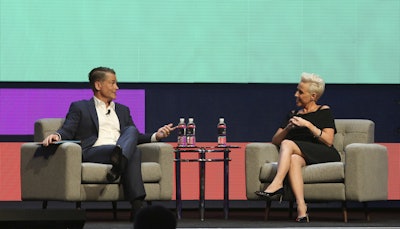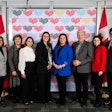
Laura Schwartz began working with camera lenses, went all the way to the White House and now she’s working with lenses again. But this time, she’s the one in front of the camera, not behind it, and she’s being broadcast from her home base of Chicago all the way to Asia and Australia.
As a child, Schwartz and her sister assisted their father in the studio that housed their family's photography business in Wisconsin, where she first learned about the power of images. Then, at 19, she began answering phones at the White House as a volunteer. Later, she became the Midwest press secretary, then the director of television. In that role, she facilitated President Clinton’s on-air speaking engagements, learning more about technology and speaking along the way.
When she stepped into her role as the White House director of events, Schwartz produced more than 1,000 events for the Clinton administration—and still holds the title of youngest female presidential appointee in history.
“When the virtual nature of events became a necessity last spring, I realized my journey up to this point really set the foundation for this,” she says.
Now, she spends 60% of her time serving as an emcee and 40% as a keynote speaker. Her clients include Mercedes-Benz, Hilton and Microsoft, among other well-known brands. Schwartz has also contributed on-air to media groups like Fox News Channel, CBS and the BBC.
When the pandemic began, Schwartz expanded her existing home studio, investing in new equipment and software to enhance her virtual speaking engagements. She was already comfortable with speaking to a camera, but she wanted to increase her capabilities technologically. “We live in an age of virtual fatigue, so I always want to make my interview look different from what the audience is doing all day long.”
Here, she offers up tips for event planners who have found themselves in the role of virtual producers amid the pandemic. “Meeting planners have an enormous responsibility and are setting the standard right now in so many ways,” Schwartz says. Regardless of the reentry process back to in-person events, she encourages event planners to consider how they can maximize their video and virtual skills.
Don’t let the presence of a camera make you dull.
“I want to make sure I’m showing the same emotion, engagement, excitement or gravity to a camera lens that I would show in person. I have to be thought provoking,” she says.
Stand up.
But keep your feet planted, as pivoting and moving around can be distracting. Schwartz taped a box on the floor as a visual border for her feet.
Position the camera so you’re captured from the waist up.
Doing so allows your audience to see your hand gestures and body language. Schwartz has found that this posture results in viewers rating the speaker as more honest and credible.
Include branding.
Schwartz invested in software that allows her to drop logos on the screen and match her background to the exact hue of an organization’s brand. If that’s not in your budget, consider what branded props, signage or backgrounds you can employ. She asks herself: If someone were watching this on mute, would they understand the gist of this event?
Use the teleprompter strategically.
When she’s not using it for prompts, Schwartz uses the teleprompter to stream her audience so she has a feel for the energy in that room and can have more of a two-way conversation. She also cautions against relying too heavily on a script. “I use it to prompt, not take the place of personality. You cannot speak in lines.”
Image: Schwartz interviews Rob Lowe for Asembia Pharmaceutical




%20(1).png?auto=format%2Ccompress&fit=crop&h=167&q=70&w=250)














